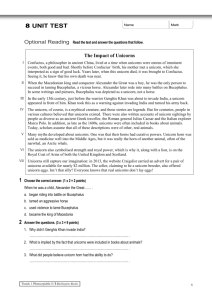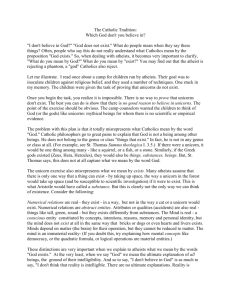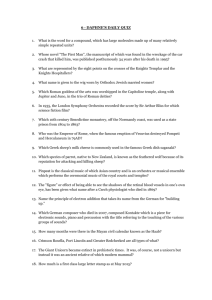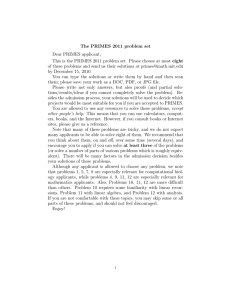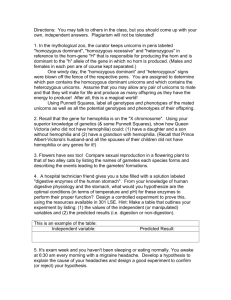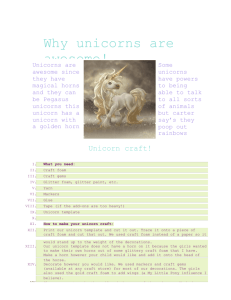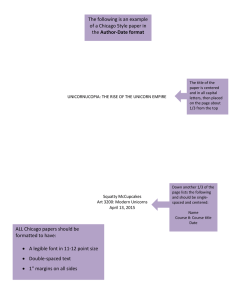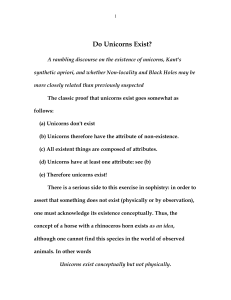Chicago: Notes Sample Paper with Bibliography
advertisement
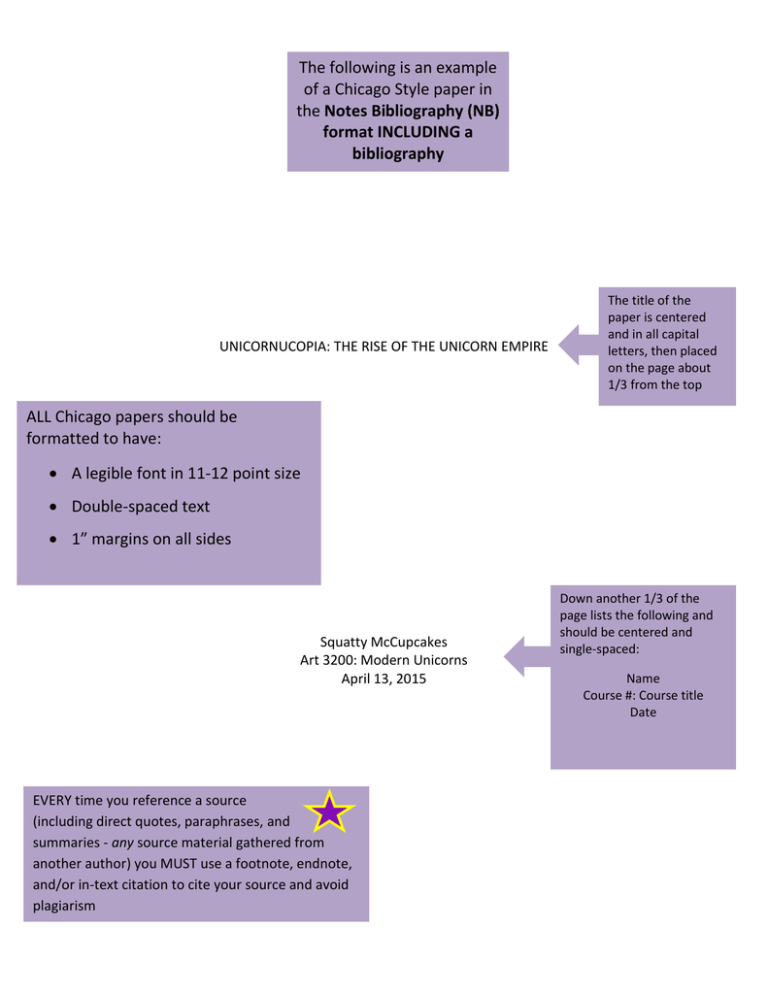
The following is an example of a Chicago Style paper in the Notes Bibliography (NB) format INCLUDING a bibliography UNICORNUCOPIA: THE RISE OF THE UNICORN EMPIRE The title of the paper is centered and in all capital letters, then placed on the page about 1/3 from the top ALL Chicago papers should be formatted to have: A legible font in 11-12 point size Double-spaced text 1” margins on all sides Squatty McCupcakes Art 3200: Modern Unicorns April 13, 2015 EVERY time you reference a source (including direct quotes, paraphrases, and summaries - any source material gathered from another author) you MUST use a footnote, endnote, and/or in-text citation to cite your source and avoid plagiarism Down another 1/3 of the page lists the following and should be centered and single-spaced: Name Course #: Course title Date Page #’s begin on the first page of text and are placed in the top right corners 1 Our world has seen many wondrous and fantastical creatures, but perhaps most popular is the unicorn. History involves some great moments as it recounts many notable unicorns: The Last Unicorn1 who freed the world’s unicorns from imprisonment in the sea, Unico2 who was NB style papers use notes to credit sources. Notice the superscripted “1” after The Last Unicorn The “1” indicates that there is a note citing this source material. At the bottom of page 1, a footnote labeled with “1” cites the source information. gifted in sharing happiness, and Twilight Sparkle of My Little Pony: Friendship is Magic3 who learns that friendship is truly a powerful and magical force. Unicorns have phenomenal mystic powers and have influenced culture with their sparkle and supreme greatness. This paper shall follow the course of the unicorn through human history, from its inception to its decline, and its ascension into popular culture. The myth of the unicorn was first documented in ancient Indian text and marks the beginning of the unicorn empire that is destined to last through eternity, adding more and more unicorns to its annals. The diversity in the unicorn empire came because of the number of admirers unicorns were able to incorporate into their minions and influence to create visual representations of their likeness and magic. Development in the areas of art, literature, and philosophy took place in the unicorn empire, as it continuously borrowed from various civilizations and cultures. The unicorns left such a mark on many world cultures that artists and writers were able to spread unicorn sparkle all over the world. Unicorns are intelligent creatures that avoided human discovery for some millennia. Hunt claims that unicorns were first documented by natural historians and were located in 1. Bass and Rankin, Jr., The Last Unicorn, DVD. Footnotes occur on the page that the source was used. Note’s 1-3 occur on page 1 and are highlighted in the text on page 1. 2. Morano, Unico, DVD. 3. Faust, My Little Pony: Friendship is Magic, Television Show. To cite sources in an NB paper, footnotes are typically used to credit sources. Since the paper includes a bibliography, the notes follow the short format which includes the AuthorLastName, Title of the Work, and page number(s) for written sources when citing specific aspects of a source For example: Smith, Unicorns Unite Smith, Unicorns Unite, 5-6 2 India.4 Unicorns cleverly disguised themselves as other horned animals to avoid discovery, which kept unicorns hidden from the human world for hundreds of years.5 As myths of the unicorns travelled across cultures and time, it spurred humankind to seek unicorns for the benefit of their mystical powers. During the renaissance, royalty were keen to hunt and trap unicorns in order to steal their horns.6 Research and history is unclear as to the development of strategies which were believed to attract unicorns and allow capture; however, it was believed that virgin maidens could attract the unicorn.7 The desire to acquire unicorn horns and prevalent belief that their horns were imbued with phenomenal healing properties causes unicorns to be hunted relentlessly and pushed them into hiding.8 The belief in the potential for human benefit from unicorns and demand from royalty likely influenced the influx of artistic representations, such as the Hunt of the Unicorn tapestries.9 Although efforts to discover and capture unicorns rose greatly during the renaissance, unicorns remained clever enough to avoid humans, resulting in an influx of fake unicorn horns from narwhals. You may find that you will use the multiple times. When Unicorns continued to fascinate humans and became more and same moresource prevalent in visual using the same source consecutively, Chicagofamily uses the term "ibid" cultures. Representations of unicorns grew in tapestries, paintings, European crests, (meaning, "in the same place") to indicate to the reader that you are 4. Hunt, “The Lore of the Unicorn,” 78. using the same source as referenced immediately above. 5. Ibid. 6. Giblin and McDermott, The Truth About Unicorns, 48-49. 7. Ibid., 128-30. 8. Hunt, “The Lore of the Unicorn,” 78. 9. Williamson, The Oak King, The Holly King, and The Unicorn, 4-28. On the left, Note 5 is using the same source and page number of note 4. Note 7 is using the same source as note 6, but a different page number. Note 8 is using a previously mentioned source, but since it is not the same as the source in note 7, the short version is used to indicate that the source has shifted from the previously mentioned source. 3 sculptures, Asian scrolls; which further supported various cultures preceding religious texts which mention the unicorn. Although unicorns remained inconspicuous, human fascination with unicorns gave rise to visual representations.10 Through visual culture, unicorns became firmly rooted in human history. For a time, unicorns quietly retreated from human eyes to remain safe from those who would hunt them for their precious horns.11 Although the unicorns fled, the idea of the unicorn continued to enchant human hearts. As visual representations continued to spread throughout the world, unicorns began to bleed heavily into popular culture through comics and film, thus ensnaring humans under their sparkly spell. While there are many examples of unicorns in popular culture, The Last Unicorn and My Little Pony have regained a firm foothold in current popular culture. Both titles have benefitted from their fan base to further promote unicorns. The Last Unicorn is currently touring with the author Peter S. Beagle, the author of the book which the movie is based upon, and is revisiting theaters and unicorn fans for the first time since 1982.12 My Little Pony, which was originally launched in 1983, has gone through four re-releases.13 Arguably, the 2010 release of My Little Pony: Friendship is Magic, has been the most successful relaunch of the series and enraptured not only female fans but also males, whom are often referred to as “bronies.” 14 As 10. Caillois and Walker, “The Myth of the Unicorn,” 17-23. 11. Williamson, The Oak King, The Holly King, and The Unicorn, 4-28. 12. The Last Unicorn Screening Tour, Conlan Press, 2013, http://lastunicorntour.com/. 13. Giblin and McDermott, The Truth About Unicorns, 105-06. 14. Ibid., 108. 4 unicorns continue to saturate popular culture, the magic and sparkle grows in the hearts of humans. Though unicorns remain mysterious and elusive, their presence in the hearts of those who love them remains strong and sparkly. Though the existence of unicorns began before the introduction of humans, the myth of the unicorn was constructed by them. The power unicorns possessed was enough to drive humans to try and acquire such power and to fascinate humans enough that visual representations of unicorns mirrored their importance to human culture. However, since the ascension of the unicorn empire, Twilight Sparkle of My Little Pony, reminds humans of the great power in friendship. Keep going! The bibliography should begin on a new page with all entries alphabetized A to Z 5 References Caillois, Roger and Walker, Scott R. “The Myth of the Unicorn,” Diogenes 30, no. 119: (1982) 1-23. Giblin, James and McDermott, Michael. The Truth About Unicorns. New York, N.Y: Harper Collins Publishers, 1991. Hunt, Kenneth. “The Lore of the Unicorn,” Colonial Homes 22, no. 6 (1996): 78. The Last Unicorn. Directed by Jules Bass and Arthur Rankin, Jr. 1982. Pinewood, England: ITC Entertainment, 2007. DVD. “The Last Unicorn Screening Tour.” Conlan Press. 2013, http://lastunicorntour.com/. My Little Pony: Friendship is Magic. Created by Lauren Faust, Produced by Hasbro Studios and DHXMedia, 2010. The Hub Network. Television Show. Unico. Directed by Moribi Morano. 1983. Japan: Madhouse and Discotek Media, 2012. DVD. Williamson, John. The Oak King, The Holly King, and The Unicorn: The Myths and Symbolism of The Unicorn Tapestries. New York, NY: Harper & Row, 1986. Spaces between bibliographic entries are double-spaced Further Resources ECU Writing http://www.ecu.edu/writing/ ECU Writing Resources http://www.ecu.edu/cs-acad/writing/wac/resources_writing_process.cfm Chicago Manual Citation Guide http://www.chicagomanualofstyle.org/tools_citationguide.html Purdue OWL Chicago Resource https://owl.english.purdue.edu/owl/resource/717/1/ Turabian Citation Guide http://www.press.uchicago.edu/books/turabian/turabian_citationguide.html Bibliographic entries are single-spaced and begin with the first line flush left and all subsequent lines for that entry are indented
